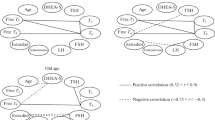Abstract
Dehydroepiandrosterone, androsterone and etiocholanolone sulphate esters have been determined in peripheral blood plasma of patients with prostatic carcinoma. A significant decrease in the plasma level of steroid was observed. A diminution in the excretion rate of certain 17-oxosteroid conjugates was also found in the same patients. There was no correlation between the steroid levels and orchidectomy or heterosexual hormone treatment.
From the findings it is assumed that an insufficient production of dehydroepiandrosterone and/or its sulphate ester in adrenal may play a role in the low steroid content of peripheral blood and urine. However, the abnormality of steroid metabolism appears to be in no close relationship with the disease, rather, it may be the consequence of an aspecific stress reaction.
Similar content being viewed by others
References
Acevedo, F. H., Goldzieher, W. J.: The metabolism of (4-14C)-androstene-3,17-dione by normal human prostatic tissue.Biochem. biophys. Acta 82, 118 (1964).
Baulieu, E. E., Corpéchot, C., Dray, F., Emiliozzi, R., Lebeau, M. C., Mauvais-Jarvis, P., Robel, P.: An adrenal-secreted “androgen”: Dehydroepiandrosterone sulphate. Its metabolism and a tentative generalization on the metabolism of other steroid conjugates in man.Recent Progr. Hormone Res. 21, 411 (1965).
Bénard, H., Bourdin, J. S., Saracino, R., Seeman, A.: Etude des 17-cétostéroides plasmatiques totaux et des 17-hydroxy-corticostéroides plasmatiques libres chez des hommes atteits de cancer de la prostate ou du testicule.C. R. Acad. Sc. Paris266, 604 (1968).
Bénard, H., Seeman, A.: A propos du dosage des 17-cétostéroides plasmatiques.Bull. Soc. Chim. biol. 45, 1405 (1963).
Farnsworth, E. W.: 10-Demethylation of testosterone by human prostate,in vitro.Steroids 6, 519 (1965).
Farnsworth, E. W., Brown, J. R.: Metabolism of testosterone by the human prostate.J. Amer. med. Ass. 183, 140 (1963).
Fehér, T.: Some aspects of the determination of individual urinary 17-oxosteroids: Methodology.Clin. chim. Acta 14, 83 (1966).
Fehér, T.: Some aspects of the determination of individual urinary 17-oxosteroids: Normal excretion.Clin. chim. Acta 14, 91 (1966).
Fehér, T., Koref, O., Kazik, H. M.: Simultanbestimmung von freiem Cortisol, esterifizierten Dehydroepiandrosteron und Androsteron im peripheren Blut.Acta endocr. 51, 429 (1966).
Fehér, T., Koref, O., Csellár, M., Szendrői, Z.: Prostatarákos betegek vizeletének steroidanyagcsere termékei.Magy. Belorv. Arch. 18, 159 (1965).
Gallagher, T. F., Whitmore, F. W., Zumoff, B., Hellman, L.: Steroid hormone metabolites before and after orchidectomy for prostatic cancer.J. clin. Endocr. 23, 523 (1963).
Gandy, M. H., Peterson, E. R.: Measurement of testosterone and 17-ketosteroids in plasma by the double isotope dilution derivative technique.J. clin. Endocr. 28, 949 (1968).
Isurugi, K.: Plasma testosterone production rates in patients with prostatic cancer and benign prostatic hypertrophy.J. Urol., 97, 903 (1967).
Kent, J. R., Young, H. H.: Plasma testosterone levels in patients with prostatic carcinoma.Surg. Forum 15, 485 (1964).
Pearlman, W. H., Pearlman, M. R.: The metabolism in vivo of 4-androstene-3,17-dione-7-H3: its localisation in the ventral prostate and other tissues of the rat.J. biol. Chem. 236, 1321 (1961).
Segaloff, A.: The enhanced local androgenic activity of 19-nor steroids and stabilization of their structure by 7α- and 17α-methyl substituents to highly potent androgens by any route of administration.Steroids 1, 299 (1963).
Shimazaki, J., Kurihara, H., Ito, Y., Shida, K.: Testosterone metabolism in prostate; formation of androstan-17β-ol-3-one and androst-4-ene-3,17-dione, and inhibitory effect of natural and synthetic estrogens.Gunma J. Med. Sci., 14, 313 (1965).
Szendrői, Z., Koref, O., Fehér, T., Csellár, M.: Über die Ausscheidung der Steroidstoffwechsel-Produkte im Harn bei Prostatakrebs.Arch. Geschwulstforsch. 26, 18 (1965).
Tamm, J.: Der Testosteronstoffwechsel beim Menschen.Med. Wschr. 92, 1983, 2037, 2080 (1967).
Vihko, R.: Gas chromatographic-mass spectrometric studies on solvolyzable steroids in human peripheral plasma.Acta endocr. Suppl. 109 (1966).
Young, H. H., Kent, J. R.: Plasma testosterone levels in patients with prostatic carcinoma before and after treatment.J. Urol. 99, 788 (1968).
Author information
Authors and Affiliations
Rights and permissions
About this article
Cite this article
Fehér, T., Koref, O., Szendrői, Z. et al. Androgen metabolites in blood of patients with prostatic carcinoma. International Urology and Nephrology 2, 163–169 (1970). https://doi.org/10.1007/BF02125817
Received:
Issue Date:
DOI: https://doi.org/10.1007/BF02125817



